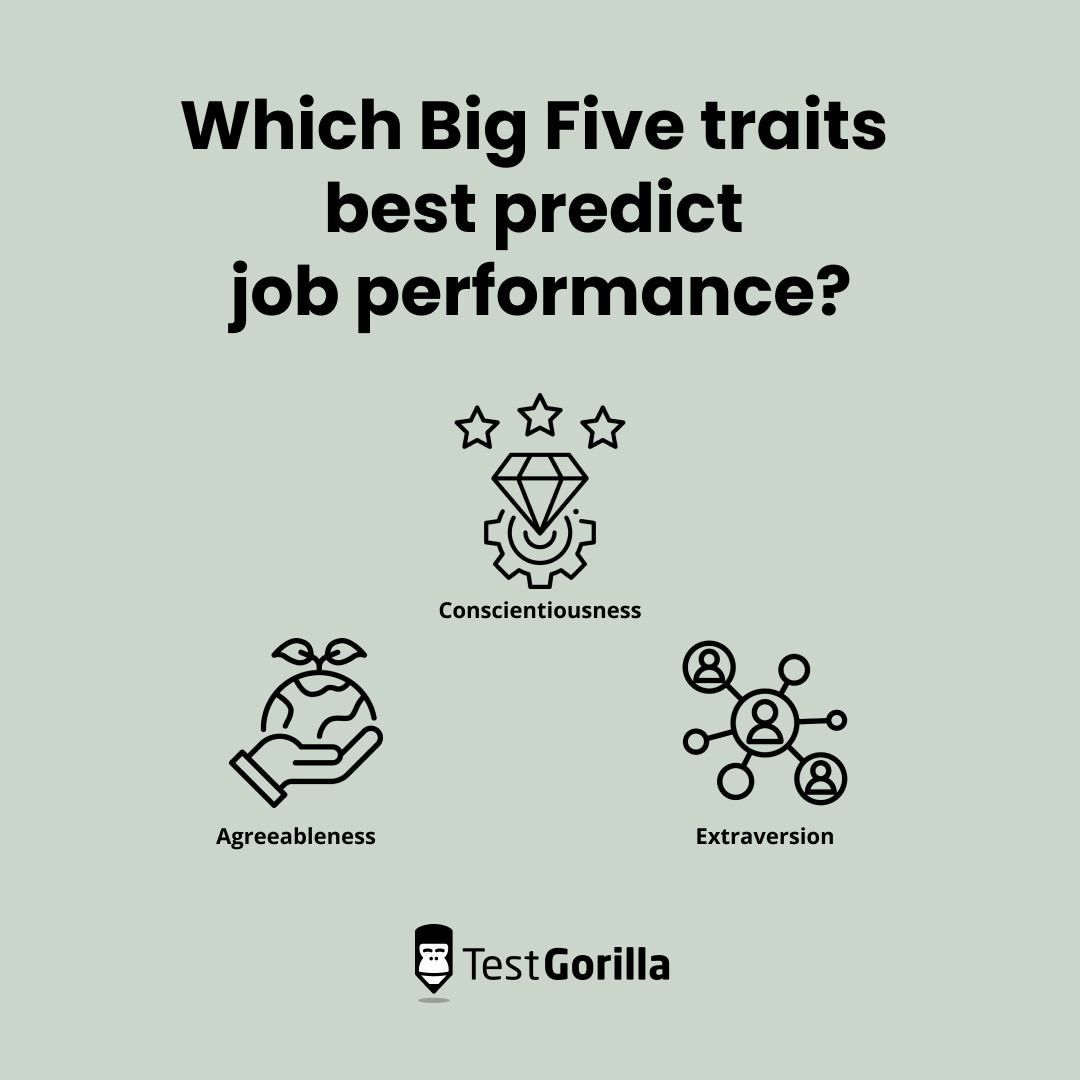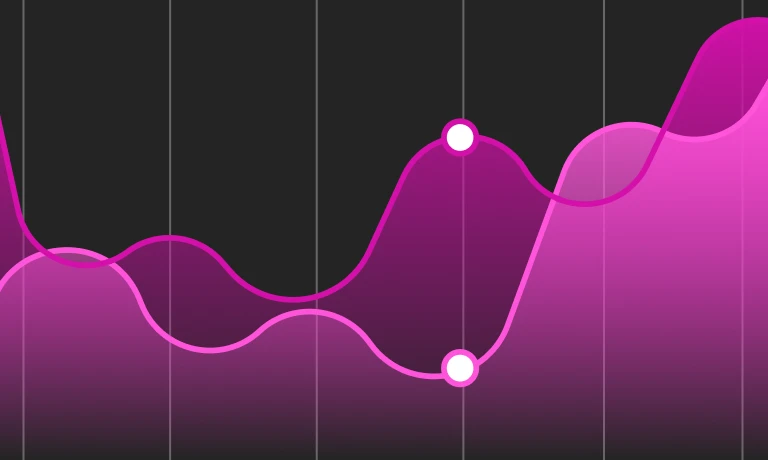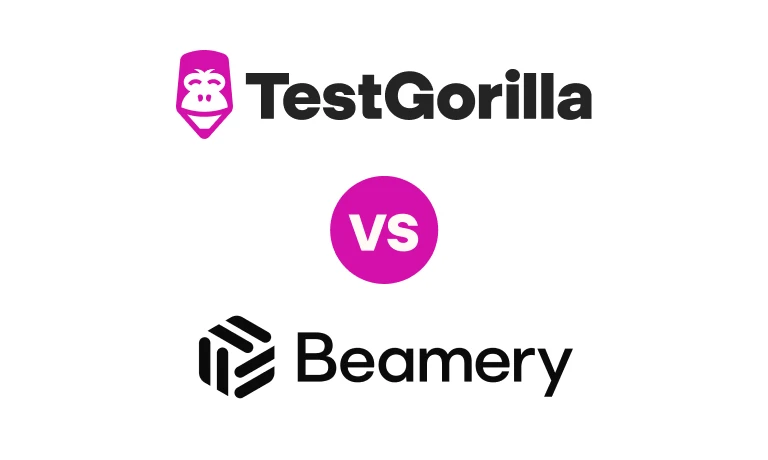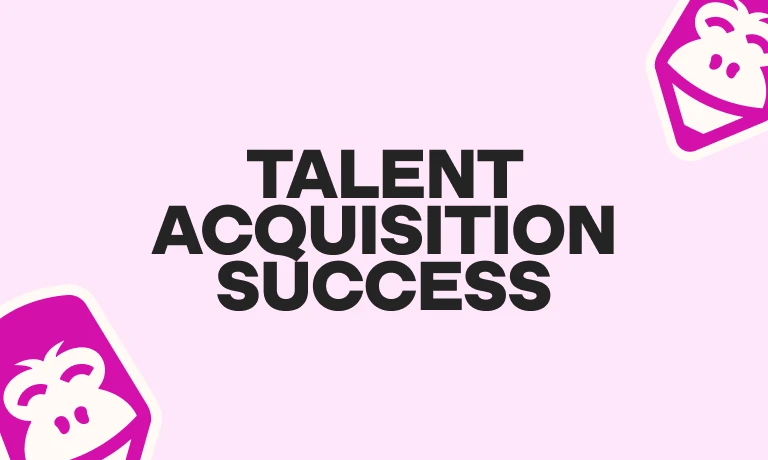Personality tests can be harnessed as valuable tools in the hiring process. Even if they don’t give you specific information on how competent or knowledgeable someone is, they can predict job performance when you combine them with other hiring tools, such as skills tests or different talent assessments.
Of all the personality tests used for hiring, the Big Five (OCEAN) is among the most researched ones. In fact, the Big Five is such a popular choice as a hiring assessment that multiple meta-analyses have been conducted to figure out which Big Five personality characteristic best predicts job performance.
So which is it?
Extraversion, conscientiousness, agreeableness, emotional stability (neuroticism), or openness to experience?
Well, in short: it depends on the position.
In this article, we’ll look into the details.
What is the Big Five model?
The initial Big Five model was developed in the 60s by Ernest Tupes and Raymond Christal, and was used in the context of hiring pilots for the US Air Force, and was further developed in the 80s and 90s. The acronym OCEAN or CANOE is often used for this test (although the standard order, as you’ll see below, is actually EAOCN).
The Big Five traits are:
Extraversion: Outgoing and energetic vs. withdrawn and solitary
Agreeableness: Compassionate and friendly vs. overly critical
Openness to experience: Curious, imaginative, and open to new experiences vs. cautious and reserved
Conscientiousness: Efficient and well-organized vs. careless
Neuroticism: Sensitive and nervous vs. confident and resilient.
Each trait is measured on a sliding scale, and everyone will fall anywhere on the continuum of each one.
Personality characteristics define our day-to-day actions, behaviors, and thought patterns; in short, they make us who we are. In addition, personality traits are common across different cultures and societies: in fact, one study by Robert R. McCrae and Antonio Terraciano showed that the validity of personal traits held up in 50 different countries.
It’s important to add that personality characteristics remain relatively stable throughout one’s life and are influenced both by one’s genetic makeup and environment (family, school, upbringing, cultural background, etc.). Heredity is thought to contribute about 50% to those character traits.
Can the Big Five personality traits predict job performance?
Researchers have studied the question in detail, and HR managers and recruiters have been using different tests and assessments of the Big Five personality traits in the workplace for a while now. Because of this, we have a lot of information available on how the Big Five personality traits relate to job performance.
Conscientiousness, or the capacity of an individual to be organized, diligent, and self-disciplined, is often quoted to be the strongest predictor of work performance. This has been confirmed by many studies, according to a meta-analysis performed by Michael P. Wilmot and Deniz S. Ones.
However, which Big Five personality trait will actually help you best predict an applicant’s future performance and make better hires depends to a big extent on the specific position.
How do different traits help predict performance based on the role?
If the position that you’re looking to fill requires a lot of networking and strong negotiation and interpersonal skills, extraversion is definitely a trait that will help someone perform well in it. Similarly, an introverted, quiet, withdrawn person will probably not be the best salesperson in the team.
On the other hand, if you’re hiring for a position where the person will need to spend hours analyzing data, extraversion is not something you should expect from your candidates (who might also be drawn to analytical roles also because they’re rather introverted).
For fast-paced environments where a strong accent is placed on the capacity to innovate and come up with new solutions, someone’s openness, inventiveness and curiosity would be key. Resilience and a low level of neuroticism will help a person thrive in stressful, dynamic and unpredictable circumstances.
Why is it important to use a data-driven approach to hiring?
Keep in mind that someone’s personality on its own isn’t what brings results to the table: the right personality traits need to be combined with skill, knowledge and experience. That’s why it’s important to pair the Big Five (OCEAN) test with other skills assessments, in a holistic, data-driven approach to hiring.
This can help you determine whether someone has the right skill set for a given role, on top of the right personality for it, and also whether they can be a successful culture add to your company.
We recommend administering personality and culture tests in combination with role-specific skills assessments, such as tests for PPC advertising, outside B2B sales, HTML5 or DevOps, for example.
Which Big Five traits best predict job performance?
For most positions, either conscientiousness, agreeableness, or extraversion are key for a strong job performance.
In this section, we’ll look into each one of these three traits, and explore the reasons why each one can be a good predictor of success, and we’ll also discuss the other two at the end.
Conscientiousness
Conscientiousness refers to how self-disciplined, organized, and orderly a person is, as well as how seriously they take their obligations and responsibilities. Of all the traits we will discuss, this trait has the most amount of research backing it as the personality trait that best predicts job performance – and for good reason.
The most comprehensive meta-analysis (by Wilmot et al.) of conscientiousness pulls from data from over 1 million participants over the past 100 years. The results show us that conscientiousness has desirable effects and outcomes for 98% of the analyzed occupational variables.
This same study identifies several characteristics common to conscientious people when at work. All of them describe highly desirable employee traits, such as
Commitment
Perseverance
Interpersonal responsibility for common goals
Preference for predictability
Self-regulatory restraint to avoid counter-productivity
Proficient performance.
As you can see, these are all traits that strong performers share, regardless of the specific role—and also, that many managers would like to see in the members of their teams.
Another meta-analysis by M. B. Barrick and M. K. Mount also confirms that conscientiousness is a reliable performance predictor.
Conscientiousness doesn’t always predict strong job performance, though. Jobs like customer service and low- to mid-complexity positions were shown to be best suited for conscientious people. Good job performance for high complexity jobs such as that of a lawyer or social worker did not correlate nearly as strongly with conscientiousness as for low-complexity jobs in healthcare.
This may be because conscientious people were shown to fulfill their potential the most in predictable environments, and high-complexity jobs often come with dynamic environments.
To benefit from your employees’ conscientiousness and fully use their occupational potential, it’s best to create a stable, predictable environment with clear, well-structured goals and objectives.
Agreeableness
Agreeableness within the Big Five model refers to people who are straightforward, compliant, and trusting. In terms of job performance, agreeableness can be indicative of strong performance, but not always. Otherwise said, the relationship between agreeableness and job performance on its own is not as strong. But when paired with certain other traits, agreeableness can be a key to success.
Agreeable people make for great team members, and to a larger effect than conscientiousness. Their characteristics make them more likable by other team members, and, as a result, easier to work with. Agreeable people can help add to a positive organizational culture and help bring out other people’s potential.
On the other side, in leadership positions, high ratings of agreeableness appear to actually have a negative effect on task performance. This likely becomes most apparent when managers have to make decisions that can’t benefit everyone, deliver bad news, or make difficult decisions. The effect of agreeableness on leadership performance is often considered ambiguous and managers with this trait are speculated to be successful in more community-orientated organizations, with a flat hierarchy.
As you saw above, conscientiousness has a strong positive effect on job performance. But one study shows that for certain positions, conscientiousness on its own is not enough. For occupations like customer service roles, where frequent cooperative interchange is required, highly conscientious workers who lack agreeableness receive lower job performance ratings. At the same time, workers high in both agreeableness and conscientiousness excel.
Then there’s political skill, which is the way we leverage our relationships to achieve goals and influence others. When we combine political skill with agreeableness we get higher performance ratings than when an individual has high scores on just political skill alone.
When we consider the bigger picture, agreeableness in the workplace is most beneficial when it works in tandem with other traits that have a more established correlation to job performance. From a hiring perspective, this means agreeableness scores should be considered in relationship to other trait scores and skills.
Extraversion
Extraversion refers to how assertive, energetic, and sociable a person is. Higher levels of extraversion are positively linked to better job performance. This is especially true for jobs that require strong interpersonal and communication skills, and where the person needs to negotiate outcomes or conditions, persuade team members or clients, or lead others. For project or department managers, team leads, business development representatives, and other similar roles, extraversion can be key.
The biggest scientific review on extraversion analyzes how different characteristics of extraverts benefit their job performance throughout their lifetime. Its authors conclude that, of 165 work-relevant variables, extraversion shows desirable effects for 90% of them, making it a persistent advantage in the workplace.
Extraversion has also been linked to regions of the brain associated with sensitivity to reward, which makes extraverts naturally predisposed to be more sensitive to and motivated by rewards at work, and by status recognition.
But what about the stereotype of the successful extroverted salesperson?
There’s actually no research to support this. It may be in fact ambiverts, i.e. those who score towards the middle of the scale of extraversion and introversion, that have the right balance of an assertive but considerate personality that would make a salesperson successful.
What about the other two traits, openness to experience and emotional stability (low neuroticism)?
The remaining two traits of the Big Five personality model can also be important for specific roles, although they’re not as consistently used to predict job performance.
Openness might be ideal for roles where the person often faces unfamiliar problems which they have to solve creatively, and where they’re often in unfamiliar territory. People who are curious, open to new ideas, and comfortable trying new things, can be well-suited for creative roles and for companies where job positions are only loosely defined, allowing for a lot of inventiveness. People who score low in this area need structure and predictability and will have a harder time expanding their comfort zones.
Neuroticism is defined as a predisposition to anxiety, irritability, or extreme sensitivity to criticism (or perceived criticism). Obviously, this might make a person more difficult to work with, especially in bigger teams and dynamic environments, but they might perform well in a predictable environment with lower levels of stress.
On the other end of the continuum, someone who is emotionally stable and resilient will be able to perform well in a fast-paced environment and deal well with adversity and difficult situations. This might be crucial for leadership positions, or for high-pressure roles where fast reactions are expected. Of course, this should never be an excuse to stretch someone’s limits or withhold praise or recognition, and organizational culture can entirely make or break your company’s success.
The best insights on HR and recruitment, delivered to your inbox.
Biweekly updates. No spam. Unsubscribe any time.
Conclusion: The Big Five personality assessment, in combination with a data-driven approach, can help you make the best hires
Experience, knowledge, and role-specific skills are key, and testing for those is crucial for making successful hires. In addition to those, using the Big Five personality test can help you better understand your potential candidates, and give you an accurate idea on how suitable they are for a specific position.
Assessing the Big Five personality traits in the workplace in combination with testing for different talents, skills and cognitive abilities, will allow you to easily compare candidates and make unbiased hires.
Related posts
You've scrolled this far
Why not try TestGorilla for free, and see what happens when you put skills first.



















